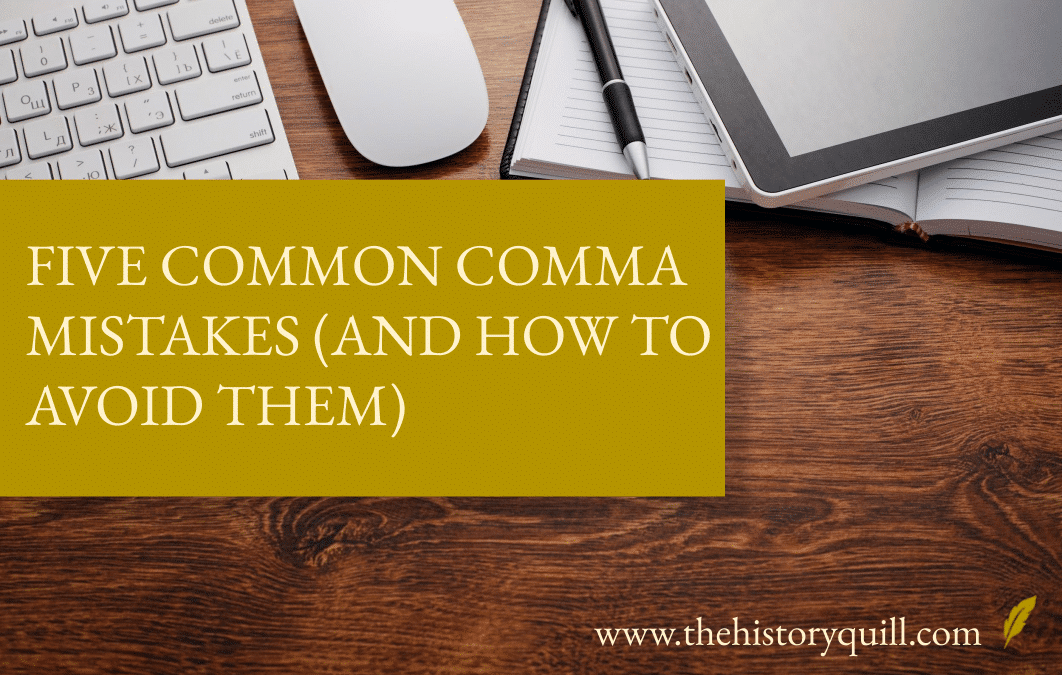Most manuscripts I edit contain some grammatical errors, and most of these relate to commas. Good comma usage can improve the flow of your story, add dramatic tension, and give the reader confidence in your writing abilities. Bad comma usage can make your writing seem unprofessional and ruin an otherwise good novel.
To help you out, here are the top five comma mistakes I encounter and how to avoid them.
1. Commas before coordinating conjunctions
There are seven coordinating conjunctions: for, and, nor, but, or, yet, and so.
When they’re being used to connect two independent clauses – that is, clauses that could exist as sentences on their own – a comma should be placed before them. For example, this sentence should have a comma before ‘and’: “The guns fired, and the cavalry charged forward.”
There is an exception to this when the two independent clauses are very short. For example: “She ran but he walked.” In cases like this, it’s usually fine to bend the rules and leave the comma out.
However, when you’re not using coordinating conjunctions to connect two independent clauses, often you shouldn’t place a comma before them. For example, there should be no comma before the ‘and’ in the following sentence: “The cavalry charged forward and attacked the retreating column.” This is a compound predicate, so the second part of the sentence is not an independent clause.
A lot of people go by the rule of thumb that commas should be used when you ‘take a breath’ in a sentence. If you were following that convention, you might be tempted to put a comma before ‘and’ in the above sentence. So remember it’s not an accurate rule, and it can lead to mistakes.
There are some circumstances under which you should place a comma before coordinating conjunctions when you’re not using them to connect two independent clauses, including when they’re used in a list of three or more items, or if it’s necessary for clarity.
2. Comma splices
Don’t use a comma to connect two independent clauses without also using a coordinating conjunction. If you do, it’s called a comma splice, which is one of the most common errors I encounter.
For example: “I ran down the street, he followed after me.” This is a comma splice because there’s no coordinating conjunction after the comma. If you don’t want to use a coordinating conjunction, you can use a semi-colon instead (“I ran down the street; he followed after me.”). Alternatively, you can just start a new sentence (“I ran down the street. He followed after me.”). But, whatever you do, don’t just use a comma by itself if the clauses are independent.
Do you write historical fiction?
Join our email list for regular writing tips, resources, and promotions.
3. Restrictive vs. non-restrictive clauses
The distinction between restrictive and non-restrictive clauses and how commas are affected can be a tricky one. If you’re adding extra (but non-essential) information to something in a sentence, use commas to section it off. For example: “Her dear brother Robert, who she hadn’t seen for months, would soon come home from the front.” Here, it’s not essential to the meaning of the sentence to know that she hasn’t seen him in months. This is called a non-restrictive clause.
However, if the information is essential, there should be no commas. For example: “The man who cooked this steak should get a medal.” Here, the information about the man is essential for identifying him. This is called a restrictive clause.
4. Correlative conjunctions
Now things are really getting exciting. Correlative conjunctions are pairs of conjunctions, such as ‘not only/but also’. Writers commonly use commas before the second conjunction in the pair, but they shouldn’t.
For example: “She not only completed the race, but also set a record.” This is actually incorrect. It should be: “She not only completed the race but also set a record.”
The same is true for ‘either/or’ sentences.
5. The Oxford comma
This one’s contentious. When you have a list of three or more items, you have the option of ending with a comma. For example: “The necklace, the pearls, and the diamond ring.” Or you can avoid it. For example: “The necklace, the pearls and the diamond ring.” Personally, I prefer using the Oxford comma, but I won’t correct you if you don’t. Even if it hurts me inside.
However, writers do sometimes err when an Oxford comma becomes necessary to provide clarity and they don’t include one. For example: “I love my sons, Andrew and Edward.” Are you saying that you love your sons and they’re called Andrew and Edward or that you love your sons AND you love Andrew and Edward? An Oxford comma would clear things up.
As ever, the biggest rule of all is that rules can be broken in the pursuit of good writing. Sometimes, for example, it’s possible to put commas where they shouldn’t really go because it adds emphasis or drama to a sentence. For instance: “I came, I saw, I conquered.” Technically, the final comma is a comma splice, but it sounds better without a conjunction, don’t you think? Occasionally, correct comma usage can also make a sentence sound unnecessarily clunky or unnatural. In such circumstances, you would be right to bend the rules and trust your eye. And, of course, if a comma is necessary for clarity, always include it.
Do you write historical fiction?
Join our email list for regular writing tips, resources, and promotions.

